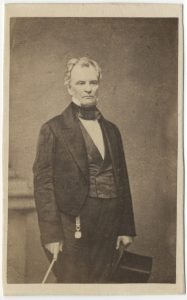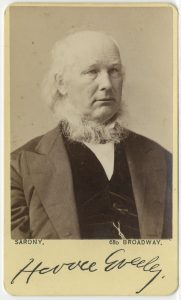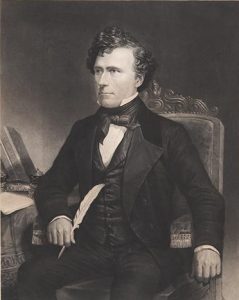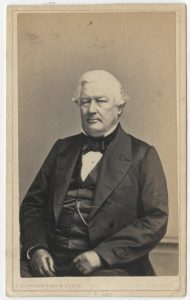Lincoln’s Domestic Policy
Toward a More Modest Conception of the Presidency by Jon D. Schaff
Charles and Mary Beard, in The Rise of American Civilization, make the claim that the Civil War constituted a “Second American Revolution.” The noted historian James McPherson, in his book self-consciously titled Abraham Lincoln and the Second American Revolution, echoes the Beards’ conclusion. While all would agree that the emancipation of slaves, first in the Emancipation Proclamation and then in the 13th Amendment, had a profound influence on American history, McPherson goes beyond slavery in his claims. The Civil War era was also “revolutionary” in what we might call domestic policy. By domestic policy I mean policy not associated with military or foreign policy. Of course, a civil war is by definition “domestic,” but in using the term “domestic policy” I wish to separate the more mundane policies of government from those more traditionally associated with high statesmanship, namely diplomacy and military leadership. In this sense, McPherson points to a number of Civil War-era domestic policies he considers “revolutionary.” Among these are the Homestead Act, the Morrill Act (aka the Land-Grant College Act), the Pacific Railroad Act, the Legal Tender Act, and the National Bank Act. Borrowing from Leonard Curry, McPherson argues that these policies taken as a whole formed a “blueprint for modern America” and that Abraham Lincoln was one of the “principle architects” of what McPherson calls a “capitalist revolution.”
Lincoln, to be sure, is often considered one of our more aggressive presidents in his use of the powers of the office. Clinton Rossiter went so far as to call Lincoln a “constitutional dictator.” On the other hand, David Herbert Donald referred to Lincoln as a “Whig in the White House.” The Whig Party, in which Lincoln achieved his political maturation, took its name precisely from Great Britain’s anti-crown party as the American Whigs originated in response to the perceived abuses of the presidency by Andrew Jackson. There is a reason why they derisively referred to Jackson as “King Andrew.” Lincoln, however, is looked upon as a model for those who wish to promote an active government headed by an aggressive presidency. Not surprisingly Lincoln was admired in his use of presidential power by such Progressive luminaries as Theodore Roosevelt, Woodrow Wilson, and the founder of The New Republic, Herbert Croly. Wilson, in Constitutional Government in the United States, opines that the president is the “political leader of the nation” and the country “craves a single leader.” More recently the late Mario Cuomo, former governor of New York, argued in his book Why Lincoln Matters that Lincoln would adopt the modern progressive platform almost in total. Indeed, he provides a mock State of the Union speech by a contemporary Lincoln in which Lincoln’s views are hardly distinguishable from the modern Democratic Party platform. It is no accident than when Barack Obama announced his run for the presidency in the 2008 election he did so from Springfield, Illinois and invoked Lincoln in support of his agenda.
Can Lincoln’s example justify today’s presidency-centered government supported by both political parties? Study of Lincoln is typically the purview of historians and naturally so. But on this question political science can help us grasp Lincoln’s place in the history of presidential power. We can turn to three separate political science literatures to adjudicate the claim that Lincoln was a “principle architect” of a policy revolution and a model for the modern strong presidency. One of those literatures is precisely that of presidential studies. Presidential scholars tend to divide the office into pre-modern and modern eras. The conventional opinion proposes Franklin Roosevelt as a pivotal figure in presidential history. Roosevelt, it is argued, used the powers of the presidency so effectively and so transformed the office as to create a new “modern presidency” that is qualitatively different from the “pre-modern” presidency. Nineteenth century presidents are usually denigrated as “mere clerks” doing the bidding of a powerful Congress. While Lincoln is rightfully seen as a strong war leader, the question is whether that strength translated to what I term domestic policy in defiance of 19th Century conventions.
A second political science perspective is that of public policy studies. One of the ways in which political scientists study public policy formation is through what is termed policy typology. This theory essentially holds that the politics of policy development differ based on the type of policy being debated. Theodore Lowi describes three kinds of policy: distributive, regulatory, and redistributive. Distributive policy, as the name indicates, is simply the distribution of government largesse. Public works projects are classic examples of distributive policy. This policy type is typically low conflict and any differences of opinion are resolved at the congressional committee level. Regulatory policy is policy that influences individual business decisions. Redistributive policy involves redistributing resources (usually money) from one social class to another. Because regulatory and redistributive policy create greater conflict they must be resolved at a higher level, often that of congressional leadership or even the presidency. Lowi contends that the 19th Century was dominated by distributive policy, which explains why it tended towards congressional dominance. However, what if the policies advocated by Lincoln had some characteristics of the more conflictual policy types? Might we see greater presidential leadership from Lincoln than was typical of his era?
Finally, realignment theory might help us determine the extent to which Lincoln was a “principle architect” of a revolution. Perhaps as the Republican Party replaced the Whigs and swept into office in 1860 they did so not just as an anti-slavery party but also as a party advocating a definitive economic vision. Lincoln’s victory in 1860, therefore, could be read as an endorsement of an economic agenda. Also, as the first Republican president perhaps Lincoln was central in orchestrating this partisan realignment. There are two theories of partisan realignment. We might term these “bottom-up” versus “top-down.” The question is whether partisan realignments are caused by shifts in the electorate that elites capitalize upon after the fact (bottom-up) or whether partisan disquiet first occurs among elites who then lead the public towards a new set of issues and, ultimately, new partisan alignment (top-down). Naturally if the latter view is true for the realignment of the 1850s and Lincoln was one of these elites driving new partisan alignments this would give credence to the “principle architect” thesis.
In applying these political science literatures to Lincoln’s presidency let me start with the realignment thesis. The Whig Party, as mentioned, formed out of opposition to the perceived abuses of presidential power by Andrew Jackson. Whigs also largely adopted Henry Clay’s “American System” economic vision promoting internal improvements, banking, and a protective tariff. Therefore, economic policy was central to Whig identity. Slavery, though, early on indicated the fissures in the Whig coalition that would ultimately lead to its demise. In 1844, within a decade of the Whig Party’s founding, the Liberty Party ran an explicitly anti-slavery campaign, siphoning votes from the Whigs and arguably costing Henry Clay the presidential election. Later the Free-Soil Party would continue this push for a more aggressive anti-slavery agenda. The Whigs, with members in both North and South, were loath to come down solidly on one side or the other of the slavery dispute. Whigs tended to hold one positon in the North and another in the South. The Compromise of 1850, negotiated by Clay, only hastened a split between these two sectional factions while the passage of the Kansas-Nebraska Act in 1854 likely sealed the party’s fate. Frustrated by the Whig vacillation regarding slavery, the Kansas bill spurred the creation of the Republican Party as an unambiguously anti-slavery party. By 1855 most anti-slavery Whigs were Republicans while the more slavery-friendly (or outright proslavery) members had joined the Democrats. It is fair to state that the Republican Party formed with slavery, not an economic agenda, as the core.
Still, the loss of the 1856 election by Republican John C. Frémont to Pennsylvanian James Buchanan convinced many Republicans that opposition to slavery alone would not gain them electoral success. In particular, support for the tariff might win them votes in Buchanan’s home state while land policy might gain the party favor in the West. Thus, the 1860 Republican platform included explicit support for the tariff, homestead legislation, and a railroad to the Pacific. While the absence of public opinion polling makes it difficult to draw definitive conclusion regarding this strategy, Lincoln won the states of Pennsylvania, Indiana, Illinois, and California, all of which had gone to Buchanan in 1856. My tentative conclusion is that while resistance to slavery was central to the Republican message, economic issues could be said to have put the party “over the top” and were important in assembling the coalition that brought the party success in 1860. Yet, this does not seem to be enough to claim that economics drove the realignment of the 1850s. The main impetus was clearly slavery.
Further, was this realignment bottom-up or top-down, and if top-down was Lincoln one of the leaders of the party realignment? Assuming it was top-down, figures such as Salmon Chase and William Seward have as much claim as anyone to national leadership. But the Republican movement also occurred on a state-by-state basis, as was typical of an era of strong state parties. Individuals such as William Fessenden in Maine, Benjamin Wade in Ohio, Anson Morrill in Maine, and Thaddeus Stevens and David Wilmot in Pennsylvania were essential to the building of state parties. Newspapermen such as Horace Greeley of the New York Tribune and Joseph Medill of the Chicago Tribune were also key figures in spreading the Republican message.

Lincoln, though, does not seem to have taken an important position in growing the nascent party. Long an active Whig organizer, Lincoln was tardy in joining the Republican Party, not signing on until 1856, at least a year after most all of the party’s leading lights had joined. Lincoln campaigned for Frémont in 1856, even getting some support for the vice-presidential role. He then turned his attention to beating Stephen Douglas in the monumental 1858 Senate election in Illinois. His notoriety heightened by his narrow loss to Douglas, Lincoln then traveled the country in 1859-1860 advocating his anti-slavery principles. At this point Lincoln’s attention seems to be almost exclusively on slavery. He rarely discussed economic matters. To the extent that Lincoln gained national prominence, it was not based on “domestic policy.” Even if the Republican realignment was of a top-down variety, it is not accurate to say that Lincoln led the Republicans on a policy revolution. His approach to the joining the Republican Party was cautious. His selection as presidential nominee in 1860 was precisely because he seems less radical and less obviously ambitious than alternatives such as William Seward and Salmon Chase. It is worth noting that Lincoln’s election to the presidency was an effect not a cause of partisan realignment. Lincoln’s dedication to Republicanism was primarily based on opposition to slavery, taking positions on other issues only after the party had come to consensus.
Regarding presidential leadership and policy typology, again the record seems to indicate little support for the “revolutionary” thesis. First of all, the land legislation of the Civil War congresses, namely the Homestead Act, the Land Grant College Act, and the Pacific Railroad Act, all passed by large majorities with little administration involvement. An investigation of congressional debate gives virtually no mention of the administration on these matters. This is not surprising as these bills were distributive in policy type, precisely the kind of legislation where presidential involvement is usually minimal. What can be said about Lincoln is that he did not veto these kinds of bills as had previous presidents, for example Buchanan’s vetoes of homestead and college legislation. Still, on these historic pieces of legislation there is little evidence that Lincoln was a “principle architect” of a “Second American Revolution.”
The Legal Tender Act and National Bank Act gained more administrative attention, however. The congressional debates on both bills are littered with references to Secretary of the Treasury Salmon Chase, often citing his opinions and reports as gospel. In addition, members cited Attorney General Edward Bates regarding constitutional interpretation. Chase regularly met privately with members of Congress to advocate for these measures. Lincoln himself got involved regarding the bank act. In his Annual Message of December 3, 1862, Lincoln promoted the “organization of bank associations, under a general act of Congress.” The creation of these banks would augment the issuing of paper money, as the national banks would be furnished “circulating notes, on the security of the United States bonds deposited in the treasury.” These national banks could control the issuing of paper money, and thus keep inflation in check. In a subsequent letter to Congress in January of 1863, Lincoln digressed from the point of the letter to make these same arguments in favor of national bank association. Chase, Interior Secretary John Usher, and Lincoln’s secretary William Stoddard personally lobbied members of Congress on the bank act. This proved crucial as the bill passed the Senate by a slim 23 to 21 margin. The bill passed the House by the narrow margin of 78 to 64.
Policy theory predicts more aggressive administration action on regulatory policies such as the Legal Tender Act and the National Bank Act. The Legal Tender Act and the National Bank Act altered the relationship between the national government and the nation’s monetary system. The Legal Tender Act and following acts taxing rival currency out of existence made national treasury notes the only currency of the nation, eventually supplanting specie as the medium of economic activity. This represented a huge increase in the government’s power to regulate currency. The bank system supplemented the act of the previous year by increasing the government’s power over the nation’s banking system.
The different kinds of policy considered in the 37th Congress brought on a different brand of leadership by Lincoln. Presidential scholars see differences between the modern and pre-modern presidents, yet this may be largely a change in public policy. The modern presidency may be simply realizing the powers that are inherent in the office. Industrialism and post-industrialism necessitate regulatory and redistributive policies that encourage presidential leadership. The modern president has institutional support for his activity in the legislative process not possessed by 19th Century presidents. Alexander Hamilton perceived that economic nationalism and a strong presidency went hand in hand. Lincoln never made the connection. His activity on the banking and currency acts elucidate the linkage of policy and politics and to the inherent potential of the presidency, but in regards to Lincoln this activity represents the exception rather than the rule. Lincoln found himself holding contradictory positions. He favored economic nationalism but not the presidential leadership possibly necessary to make such policies a reality. In all senses, Lincoln was a Whig in the White House.

Even when exerting some influence over Congress the methods Lincoln used were less revolutionary. Jeffrey Tulis, in his study of presidential rhetoric, argues Lincoln typified the “old way,” which held that the president must not comment publicly on a matter before Congress. Lincoln seldom spoke on public policy, not wishing to take a public position that would limit him in negotiation. Lincoln also preferred the written form of communication with Congress to public speeches. This is true of the matters considered here. Lincoln’s policy pronouncements were strategically placed in veto messages, messages to Congress, Annual Messages, and the like. His activity tended to be behind the scenes and through proxies. Lincoln was respecting the time-honored divisions between Congress and the Presidency. Indeed, Lincoln was criticized in Harper’s Weekly for being too deferential to Congress and not being “a great orator.” By Ronald White’s calculation, Lincoln spoke publicly fewer than one hundred times in his four years as president. By contrast, in his first term Barack Obama spoke nearly 2,000 times, almost 700 of which were formal enough to require a teleprompter. Richard J. Ellis concludes, “Lincoln was largely content to leave economic policy in Chase’s capable hands.”
Lincoln eschewed the “going public” strategy that presidential scholar Samuel Kernell says is the hallmark of the modern presidency. The pre-modern presidency, argues Kernell, engaged in a bargaining strategy, meaning elite-to-elite dialogue typically performed behind the scenes. In contrast, the modern “going public” strategy, which Kernell maintains began with John Kennedy, is elite-to-public dialogue and has more in common with electoral rhetoric than governing rhetoric. Lincoln offered no “New Freedom,” “New Nationalism,” “Square Deal,” “New Deal,” “Fair Deal,” “New Frontier,” or “Great Society.” To the extent the Civil War-era domestic legislation represented a “revolution” Lincoln was largely passive, respecting the conventions of his day.
We have reason to doubt the revolutionary nature of the era’s domestic policy. As Allen Guelzo has pointed out, while the government grew substantially during the war, at the war’s completion the government quickly returned to near pre-war levels of spending and personnel. The land legislation that is part of this “revolution” consisted largely in the government selling its land assets while creating almost no bureaucracy. Further, Lincoln could lead the executive branch of a nation at war with a staff of three secretaries. Today’s White House has a staff of nearly 400. Lincoln can hardly be said to have laid precedent for today’s activist, presidency-centered government.

The three perspectives of political science, those of presidential studies, policy typology, and realignment theory, indicate that Lincoln was not a revolutionary leader on domestic policy in the manner suggested by McPherson. This is not to deny that in his push for emancipation and in his conduct as a war president Lincoln was much more aggressive, possibly even revolutionary. Consideration of Lincoln’s presidency usually focuses on Lincoln as a wartime leader. This is understandable, but distorts the lessons of Lincoln’s presidency because Lincoln governed in a crisis, and crisis is by definition the exception not the rule. A thorough study of Lincoln’s presidency requires that we look at those aspects of his service that are more “ordinary,” not crisis driven. Using the tools of political science we can see that Lincoln’s domestic presidency exemplifies a more modest conception of the office than the presidency as it exists today.
The modern presidency-centered government promotes multiple pathologies. First, what Lowi calls the “personal presidency” relies far too much on the president personally and on the president’s personality to do all that the country needs. The danger here is that we ask more of the president that he (or she, someday) can deliver, setting the people up for regular disappointment. Further, as political scientist James Ceaser puts it, our framers were interested in minimizing the harmful effects of ambition. Putting excessive personal stake in the president gives far too much temptation to presidents to act the demagogue, as all modern presidents do to a greater or lesser extent.
Also, the extravagant attention placed on the presidency combined with electoral changes creates an atmosphere of the “permanent campaign.” Both Ceaser and Lowi note weakness of the modern political party, largely caused by reforms of our electoral system (namely the rise of primary elections) and campaign finance law (creating candidate centered campaigns and strengthening interest groups at the expense of parties), have left presidents electorally unaccountable to anyone but the people at large. In the decade before Lincoln’s election, Millard Fillmore, Franklin Pierce, and James Buchanan suffered the ignoble fate of their party denying them the presidential nomination despite being a sitting president. This is almost impossible to imagine today. The weakness of parties makes candidates more dependent on interest groups, who are almost by definition narrow and extreme. Also, because candidates must largely run on strength of personality in order to gain attention, they are encouraged to make extreme appeals, for example making extravagant promises that they cannot possibly fulfill. Governing is also affected as the long election process provides incentives for presidents and presidential aspirants, usually governors and U.S. senators, to tailor their activities not toward governing but toward positioning themselves electorally. Campaign rhetoric infects governing, which is problematic as campaign rhetoric thrives on distinctions and combat metaphors while governing rhetoric must work toward conciliation. This is the cost of the “going public” strategy eschewed by Lincoln but ubiquitous in the modern presidency.

The “personalized presidency” contributes to one final pathology, that of the perpetual crisis. We often assume that in times of crisis the president will lead the nation. In part this is due to the vigor of the office, as identified by Alexander Hamilton in The Federalist Papers. And it must be said that sometimes a crisis is really a crisis, for example a civil war! For better or worse, Americans over the last handful of decades have lived through crises of poverty, inflation, crime, illiteracy, and drugs on which we have declared war. The “war on terror” is as much a war on a concept as against any actual enemy, its very fluidity of definition allowing for maximized presidential power. We have had a health care crisis, global warming crisis, a spending crisis, an energy crisis, an immigration crisis, etc. The “war” on each “crisis” justifies ever-increasing executive power.
Lincoln illustrates a different and better way. In those parts of the government that were not in crisis mode Lincoln was largely deferential to Congress. He rarely spoke in public, and when he did speak on public policy it was rhetoric directed to Congress in the written form, as in his annual messages. In those few cases where Lincoln did involve himself or his administration in the creation of “domestic” policy such involvement was limited and behind the scenes. He did not wish to commit any actions that might suggest that the power of initiating the regular legislation of government lay anywhere but with Congress. Lincoln never claimed an electoral mandate or that his power came from “the people.” Rather he regularly couched his actions in the legal powers of the office. By limiting the expectations he had for himself as president he also limited the expectations the people had of the office.
(Jon D. Schaff is a professor of political science at Northern State University in Aberdeen, South Dakota. He is the author of Abraham Lincoln’s Statesmanship and the Limits of Liberal Democracy (Southern Illinois University Press).
